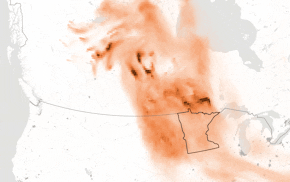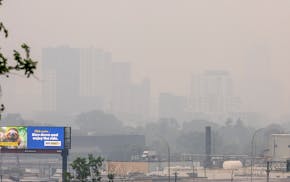Wildfire smoke, drifting thousands of miles from forests in Canada, continued to blanket much of Minnesota on Tuesday morning, creating air quality conditions that are among the poorest in the world.
Parts of the Twin Cities registered upward of 240 on the air quality index — levels considered "very unhealthy" for everyone — even as rain poured steadily across the metro region. Here's what you need to know about this week's poor air conditions, including why the rain isn't helping.
Where do I find air quality index numbers online?
The Environmental Protection Agency provides air quality index (AQI) readings at fire.airnow.gov, which also identifies where active fires are burning and where wildfire smoke is present. Or you can go to map.purpleair.com, which is run by the private company PurpleAir.
What is causing the poor air quality?
Smoke from raging wildfires in Canada is drifting thousands of miles south into the United States. More than 200 active fires are burning across Canada, with 106 considered to be out of control, according to the Canadian Interagency Forest Fire Centre.
The largest fire, measuring roughly twice the size of Hennepin County, is in the province of Saskatchewan, said Ryan Lueck, an air quality forecaster with the Minnesota Pollution Control Agency. "These fires have been burning recently for a few weeks," he said. "But recently, the winds have shifted to where the smoke that they're producing is now moving into Minnesota."
A cold front, which helps to draw the smoke close to the ground and keep it there, is also sweeping across the Midwest and prolonging the smoke exposure this week, Lueck said.
Just how bad is the air quality this morning?
The severity of Tuesday's air quality index reading is rare, Lueck said, noting that Minnesota has seen smoke concentrations this high only a handful of times in the last couple of decades. Today's smoke levels are "on par or worse" than the poor air quality days seen during the summers of 2021 and 2023.
Air quality in parts of the Twin Cities reached at least 240 on the air quality index Tuesday morning, tying the state's poorest air quality reading on record set in June 2023. That reading prompted a health alert from forecasters, who say extended exposure to the smoke could cause breathing difficulties or lung and eye irritation for everyone, not just people with asthma and other vulnerable populations.
Why isn't the rain washing out the smoke?
In normal circumstances, it would. But Tuesday's storm front is also drawing down heavy concentrations of smoke from the upper atmosphere, said Lueck. "A lot of people are probably a little confused when they walk outside to see it raining, but then also to smell all the smoke," he said.
Rain needs to be heavy and persistent enough to wash out hazardous particles, such as wildfire soot, from the air, Lueck said. The rain on Tuesday was steady enough to help clear some it, but because the smoke concentrations are so heavy, including in the upper atmosphere, the situation is essentially breaking even.
The smoke is already starting to clear out of northwestern Minnesota as of Tuesday and forecasters anticipate ending the air quality alert by midday Wednesday.
The AQI in my area is red instead of purple, am I OK?
It depends. AQI is separated into categories based on the severity of the health risk: Orange is unhealthy for sensitive groups; red is unhealthy for everyone. Purple is very unhealthy, and maroon is hazardous.
People with breathing conditions such as asthma or chronic obstructive pulmonary disease (COPD) are going to feel the effects of bad air before others. Young people and the elderly are also more affected. These categories are on a spectrum — and it's possible otherwise healthy people will start to feel the effects shortly before the meter turns red.
Generally, health experts say people should limit their exposure to smoke on poor air quality days, even when the warning is for sensitive groups. Long-term exposure to wildfire smoke, which research shows is particularly harmful, can increase the chances of developing health complications, including lung disease, cardiovascular disease and premature death.
How do I protect myself?
Experts advise that well-fitting respirators designed to filter tiny particles, like an N95, will offer protection for those who have to be outside. The KN95, which meets less-rigorous standards, will also help but may not filter as much, they say.
Lueck said, when possible, people should stay inside on poor air quality days such as Tuesday, noting that HEPA air filters on air conditioning systems help to filter out the harmful particles in smoke. But in general, he added, be aware of the forecast so you can gauge the appropriate actions to take.
What's the role of climate change?
Generally, higher temperatures and drought make it easier for fuels on the forest floor to ignite and burn.
The Intergovernmental Panel on Climate Change has noted in several reports that a warmer planet is an "added stress" that can contribute to wildfires in North America. Development patterns and forest management also play a role, the IPCC said.
Canada has been remarkably dry and hot in recent years, including this spring. Lueck said Canada is already seeing "a very active, very early" wildfire season. "As far as climate change goes, it increases the chances for above average temperatures and for an earlier start to the wildfire season," he said.
Should we expect more poor air quality days this summer?
Yes, unfortunately.
Canada was forecast to have a typical spring and a summer with above average temperatures, Lueck said. "If those outlooks remain true, and there's limited precipitation, we're going to continue to see wildfire activity extending through the rest of the summer and, therefore, providing additional opportunities for smoke to come into Minnesota," he added.
Chloe Johnson of the Minnesota Star Tribune contributed to this story.

Drainage work stalls at mine pit that could flood small Iron Range town
Land snorkeling is the latest outdoors trend. So what exactly is it?

Watch wildfire smoke turn Minnesota's air quality into the worst in the U.S.

